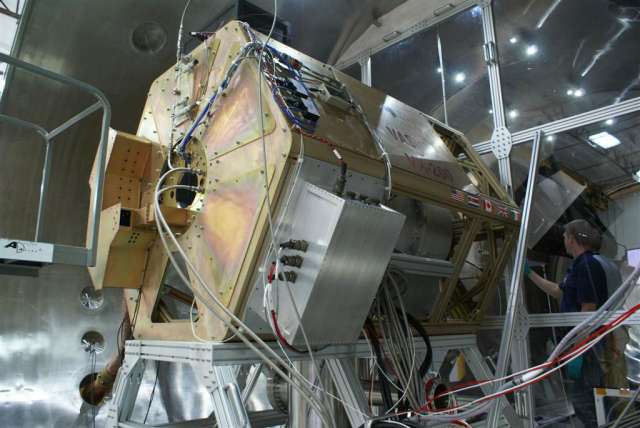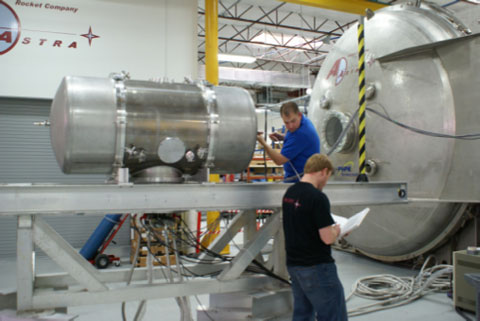The VX-200 Variable Specific Impulse Magnetoplasma Rocket (VASIMR) electric/plasma rocket is being prepped for its first flight test on the ISS around 2010. If it works for re-boosting the ISS's orbit the next step will be using it to power spacecraft. This could be using solar power for small spacecraft or nuclear for larger and manned missions using multiple VASIMR modules. Think in terms of an 'impulse drive'
Yes space fans, VASIMR is leaving the lab and heading for the real world.
Pics below...
Presser PDF....
VASIMR VX-200

MAGNET

Yes space fans, VASIMR is leaving the lab and heading for the real world.
Pics below...
Presser PDF....
VASIMRâ„¢ VX-200 superconducting
magnet delivered to Houston facility and
passes all acceptance tests.
[Houston, TX. For immediate release] – The
VX-200 low temperature superconducting
magnet has been delivered to Ad Astra’s
Houston facility by its manufacturer, Scientific
Magnetics Ltd. of Oxford, England and has
successfully passed a battery of acceptance tests
conducted by a combined team from Scientific
Magnetics and Ad Astra. The superconductor is
an essential component of the VASIMRâ„¢
engine and is responsible for generating the
strong magnetic field required to fully heat and
accelerate the plasma in the engine.
Short for Variable Specific Impulse
Magnetoplasma Rocket, VASIMRâ„¢ is a new
high-power plasma-based space propulsion
technology, initially studied by NASA and now
being developed privately by Ad Astra. A
VASIMRâ„¢ engine could maneuver payloads in
space far more efficiently and with much less
propellant than today’s chemical rockets.
Ultimately, VASIMRâ„¢ engines could also
greatly shorten robotic and human transit times
for missions to Mars and beyond.
The new magnet arrived at Ad Astra’s Houston
facility on February 10 and was unpacked by
Scientific Magnetics personnel with assistance
of the Ad Astra technical team. The system
subsequently underwent two complete one-week
thermal and magnetic cycles from room
temperature to cryogenic conditions inside its
own vacuum jacket. At its nominal operating
temperature of 5 oK (-268 oC), the magnet was
energized to its full field capability of 2 tesla
(maximum on axis). The field was measured and
compared with predicted values. The difference
between measurement and prediction was found
to be well within acceptable margins (less than
0.3%).
>
magnet delivered to Houston facility and
passes all acceptance tests.
[Houston, TX. For immediate release] – The
VX-200 low temperature superconducting
magnet has been delivered to Ad Astra’s
Houston facility by its manufacturer, Scientific
Magnetics Ltd. of Oxford, England and has
successfully passed a battery of acceptance tests
conducted by a combined team from Scientific
Magnetics and Ad Astra. The superconductor is
an essential component of the VASIMRâ„¢
engine and is responsible for generating the
strong magnetic field required to fully heat and
accelerate the plasma in the engine.
Short for Variable Specific Impulse
Magnetoplasma Rocket, VASIMRâ„¢ is a new
high-power plasma-based space propulsion
technology, initially studied by NASA and now
being developed privately by Ad Astra. A
VASIMRâ„¢ engine could maneuver payloads in
space far more efficiently and with much less
propellant than today’s chemical rockets.
Ultimately, VASIMRâ„¢ engines could also
greatly shorten robotic and human transit times
for missions to Mars and beyond.
The new magnet arrived at Ad Astra’s Houston
facility on February 10 and was unpacked by
Scientific Magnetics personnel with assistance
of the Ad Astra technical team. The system
subsequently underwent two complete one-week
thermal and magnetic cycles from room
temperature to cryogenic conditions inside its
own vacuum jacket. At its nominal operating
temperature of 5 oK (-268 oC), the magnet was
energized to its full field capability of 2 tesla
(maximum on axis). The field was measured and
compared with predicted values. The difference
between measurement and prediction was found
to be well within acceptable margins (less than
0.3%).
>

MAGNET






Comment